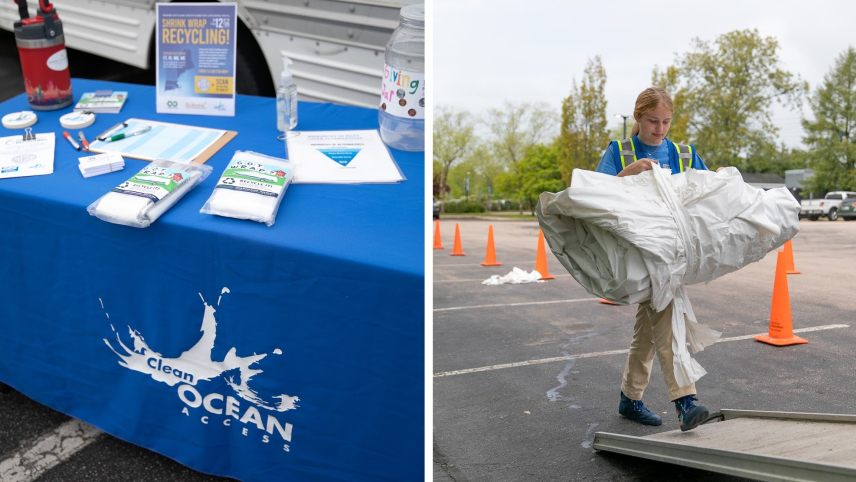Home to more than 300 species of marine mammals, fish, birds, invertebrates, and reptiles, Mystic Aquarium offsite link engages nearly 750,000 people in Connecticut every year to learn about these unique animals that are otherwise difficult to encounter. Mystic Aquarium is one of 25 aquariums and marine science education centers across North America that make up the Coastal Ecosystem Learning Centers (CELC) network. Together this network engages the public in protecting coast and marine ecosystems and work on shared priorities, such as youth engagement.
Teen volunteers from Mystic Aquarium work with Clean Ocean Access to collect and recycle shrink wrap at a marina in Connecticut. (Image credit: Mystic Aquarium)
The network worked with a team of high school aquarium volunteers to plan the 2021 CELC Virtual Youth Summit, which brought together more than 60 aquarium high school volunteers from the CELC network to hear from speakers on how to make a difference for the ocean through art, writing, advocacy, and more.
A group of teens from Mystic Aquarium attended the summit and received funding from NOAA and the North American Association for Environmental Education offsite link to take what they learned to design and lead an action project in their local community. The team chose to work with a non-profit organization to implement a project that focused on raising awareness on plastic pollution and recycling a common type of plastic used on boats. We asked the teens to reflect on their project and what they learned through their experiences. Read what they shared below!
Tell us the story of your project.
Working with Clean Ocean Access offsite link, a non-profit organization based in Rhode Island, we hosted the first ever shrink wrap recycling event in Connecticut. Shrink wrap is a plastic sheet commonly wrapped around boats for protection throughout the cold New England winter. Held in combination with Mystic Aquarium’s Endangered Species celebration, we wanted to highlight the impact of plastic pollution (in all its forms) on our local coastal environment. In Connecticut it is estimated that about 752 tons of plastic are disposed of annually. As there are no recycling programs in Connecticut for shrink wrap, it either ends up being thrown away, burned for energy, or it becomes marine debris.
Clean Ocean Access has been hosting recycling drives and partnering with marinas through Massachusetts, Rhode Island, and New Hampshire to collect shrink wrap to be converted to multi-use resin pellets to be used to create other items. As the first program in Connecticut, we look forward to continuing these efforts and working more with the boating community on recycling shrink wrap and shrink wrap alternatives that help to protect coastal ecosystems from plastic pollution.

What went well in the project, and what did not go according to plan?
This project went very well, and we considered it to be a success! The Clean Ocean Access team, who has experience with hosting shrink wrap recycling events, assisted us with organizing the event by finding the correct location at the Aquarium to host the collection, securing a hauler for the shrink wrap, marketing the event in Rhode Island, and being onsite during the event to oversee the preparation of the shrink wrap for recycling. Working with the Aquarium’s social media team, this event was also highlighted with a news release and through social media. It caught the attention of the Connecticut Department of Environmental and Energy Protect, who promoted it to the Connecticut boating community. We also provided all the participants with free vouchers to visit the Aquarium before the end of the year.
We had no major challenges, but there are a few things we will plan to do differently next year. We are hoping to host the program a few weeks earlier to work with more marinas when they are at their busiest removing shrink wrap from the stored boats. There is also a plan to reach more recreational boaters who store their boats at their homes and not in a facility. Finally, there is a long-term plan to work with West Marine, a company that operates a chain of boating supply and fishing retail stores, and marinas to become permanent recycling stations throughout the year.
What impact did your project have?
This was the first ever shrink wrap recycling event in Connecticut! We collected wrap from 40 boats and worked with West Marine stores and 34 marinas in two states. This event directly supported one of the priority issues identified by the recently accepted Long Island Sound Marine Debris Action Plan, and the Youth Conservation Corps hopes to be a leader in reducing shrink wrap plastic debris.
How did the project impact you?
Shrink wrap pollution was not something that our group was very familiar with, but that has a big impact on our coastline. There are over 90,000 registered boats in Connecticut, and if even half of them use shrink wrap on their boats, that is almost 2,000,000 tons of plastic used each year. We all know to refuse, reduce, reuse, and recycle single-use plastics like cups, straws, and utensils, but now we have to go even further!



